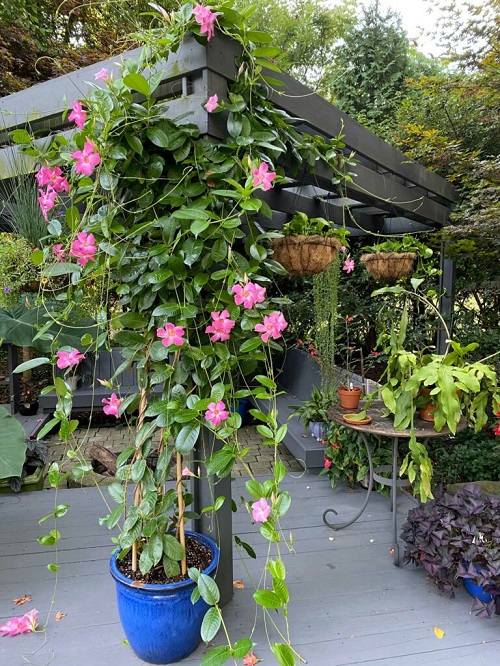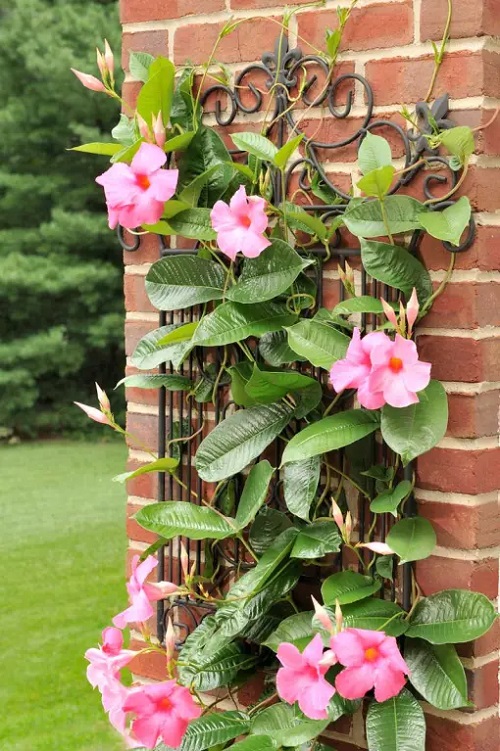Our Mandevilla Splendens Care and Growing Guide is all you need to grow this mesmerizing plant in your home garden easily!
Mandevilla Splendens exudes an aura of exoticism with its captivating beauty. Its lush green leaves provide a perfect backdrop for its bright pink trumpet-shaped flowers, which seem to glow in the sunlight. When it is in full bloom, it is a treat to watch, and its fragrance fills the air with a sweet, subtle scent.
- Mandevilla Splendens is a flowering plant species that belongs to the family of Apocynaceae
- It is commonly known as Mandevilla or Dipladenia.
- It is native to Central and South America, and it grows as a climbing vine or a shrub.
- This plant can reach up to 10 feet in height.
- Mandevilla Splendens require full sunlight to grow.
- It loves well-draining soil.
- The plant is a favorite among gardeners due to its showy flowers, and it is often used as a decorative plant for patios, balconies, and gardens.
Learn How to Grow Mandevilla in Pot here
Mandevilla Splendens Information
Mandevilla Splendens, also known as Dipladenia Splendens, is a popular flowering plant species belonging to the family Apocynaceae. The plant features dark green, glossy leaves, and large trumpet-shaped flowers that come in a range of colors, including pink, red, and white.
Mandevilla Splendens is generally easy to care for and requires full sunlight to grow. It can tolerate a variety of soil types as long as they are well-draining. In colder climates, the plant can be grown indoors as a potted plant during the winter months. This plant is known for traditional medicine uses, making it more appealing for every gardener.
Botanical Name: Mandevilla Splendens
Click out the Best Flowers for Balconies here
Propagating Mandevilla Splendens

- Look for a stem on the Mandevilla Splendens plant that is healthy, disease-free, and about 4-6 inches long.
- Using a clean, sharp pair of pruning shears, make a clean cut on the stem about ¼ inch below a leaf node. Make sure to use a sterile tool to prevent any potential diseases.
- Remove all but the top two or three leaves from the cutting. This will help the cutting focus its energy on growing roots instead of supporting leaves.
- Dip the cut end of the stem into rooting hormone powder, tapping off any excess powder.
- Fill a small pot with a well-draining potting mix and make a small hole in the center. Gently place the stem cutting in the hole, being careful not to disturb the rooting hormone powder. Press the soil around the stem to help it stay upright.
- Water the cutting thoroughly, making sure the soil is moist but not waterlogged.
- Place the pot in a warm, bright, and humid spot with indirect sunlight. Mist the cutting regularly to keep it humid, but avoid overwatering it.
- Roots will start to form in a few weeks, and once the roots are established, the Mandevilla Splendens cutting can be transplanted into a larger pot or directly into the garden.
Here are Common Mistakes While Propagating Plants from Cuttings
Layering method:
- Identify a healthy, disease-free stem on the Mandevilla Splendens plant that is flexible enough to bend toward the ground without breaking.
- Bend the selected stem towards the ground, making sure that the stem remains attached to the parent plant. (Use a wire or a small stake to hold the stem in place if needed.)
- Use a sharp and clean pair of pruning shears to make a shallow cut on the underside of the stem, about halfway between the parent plant and the end of the stem. Make sure not to cut all the way through the stem.
- Dust the cut area with rooting hormone powder to encourage root growth.
- Cover the cut area with moist soil or peat moss, making sure that it is firmly in contact with the stem.
- Use garden wire or a small stake to secure the soil in place and prevent it from shifting or washing away.
- Roots will start to form from the cut area in a few weeks, and once they are established, the new plant can be separated from the parent plant.
- Once the roots are established, gently cut the new plant from the parent plant, being careful not to damage the new roots. Plant the new plant in a well-draining potting mix or directly in the garden.
- Water the new Mandevilla Splendens plant regularly and keep it in a warm, bright, and humid spot with indirect sunlight.
Love Herbs? Check out Herbs You Can Grow from Layering here
Mandevilla Splendens Growing Requirements

Sunlight
Mandevilla Splendens prefers bright, indirect sunlight. It can tolerate some direct sunlight in the morning or late afternoon, but too much direct sunlight can damage the leaves.
If grown indoors, it should be placed near a bright, sunny window. When grown outdoors, it should be planted in a spot that receives partial shade to protect it from intense sunlight.
Soil
Mandevilla Splendens prefers well-draining soil that is rich in organic matter. A soil mix of peat moss, perlite, and vermiculite is ideal for this plant. It also prefers a slightly acidic soil pH between 5.5 and 6.5.
Learn some Great Tips to Rejuvenate Your Old Soil here
Water
This plant requires moderate watering that ensures the soil is consistently moist but not waterlogged, and it should be allowed to dry out slightly between watering.
Overwatering can cause root rot and other diseases, while underwatering can cause the leaves to wilt and drop off.
Learn How To Water Plants While Away here
Temperature and Humidity
Mandevilla Splendens prefers warm temperatures between 70-90°F (21-32°C) during the day and 60-70°F (15-21°C) at night.
It can tolerate slightly cooler temperatures during the winter months but should be protected from frost and freezing temperatures. Mandevilla Splendens prefers moderate to high humidity levels. If grown indoors, it should be placed in a room with a humidifier or misted regularly to maintain humidity levels.
Here are Ways To Increase Humidity For Houseplants That Work
Mandevilla Splendens Plant Care
Fertilizing
Mandevilla Splendens benefits from regular fertilization to promote healthy growth and abundant blooming.
A balanced fertilizer with equal amounts of nitrogen, phosphorus, and potassium can be applied every 3-4 weeks during the growing season (spring and summer).
A slow-release fertilizer can also be added to the soil at the beginning of the growing season to provide long-lasting nutrients.
Want to Make Organic Fertilizers from Kitchen Scraps? Click here
Pests
This plant can be susceptible to a variety of pests, including spider mites, whiteflies, mealybugs, and scale insects.
Regular monitoring of Mandevilla Splendens can help detect infestations early, and spraying with insecticidal soap or neem oil can help control the pests. Keeping the plant clean and free of debris can also help prevent pest infestations.
Click here to learn the Amazing Natural Pesticide Recipe that can Kill any Pest
Diseases
Mandevilla Splendens can be susceptible to fungal diseases such as powdery mildew, leaf spot, and stem rot.
To prevent these diseases, make sure to provide adequate air circulation around the plant, avoid overwatering, and remove any diseased leaves or stems promptly. Fungicidal sprays can also be used to control fungal infections.
Learn How to Dispose of Diseased Plants and Weeds here
Mandevilla Splendens Toxicity
It is mildly toxic to humans and pets if ingested, as Mandevilla Splendens contains a toxic substance called iridoid glycosides, which can cause vomiting, diarrhea, and other gastrointestinal problems if ingested.
It is important to keep the plant out of reach of children and pets and to wash your hands thoroughly after handling the plant.




